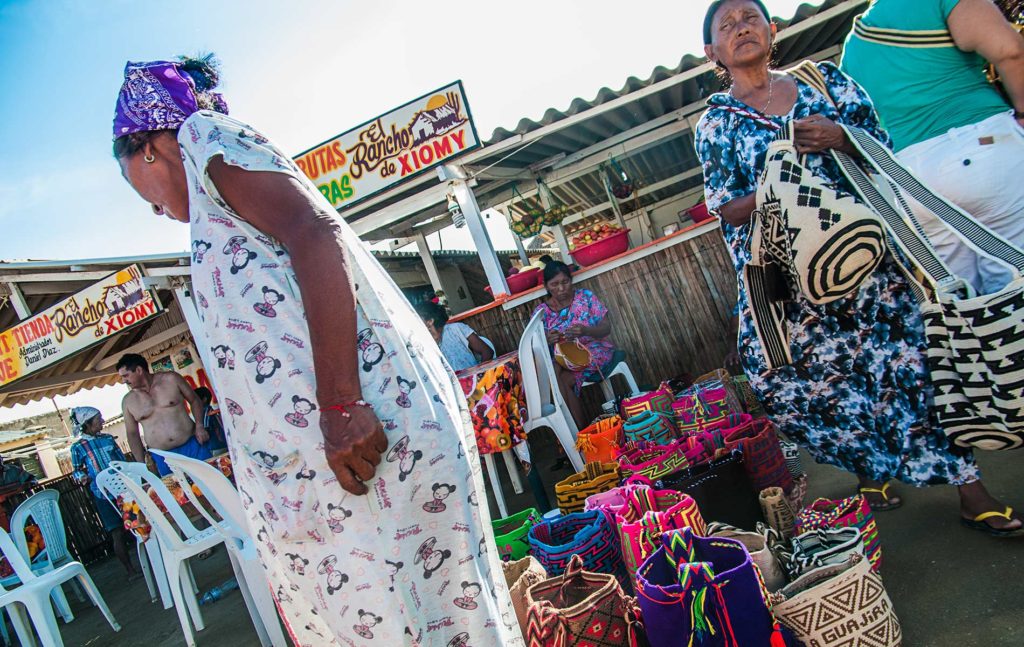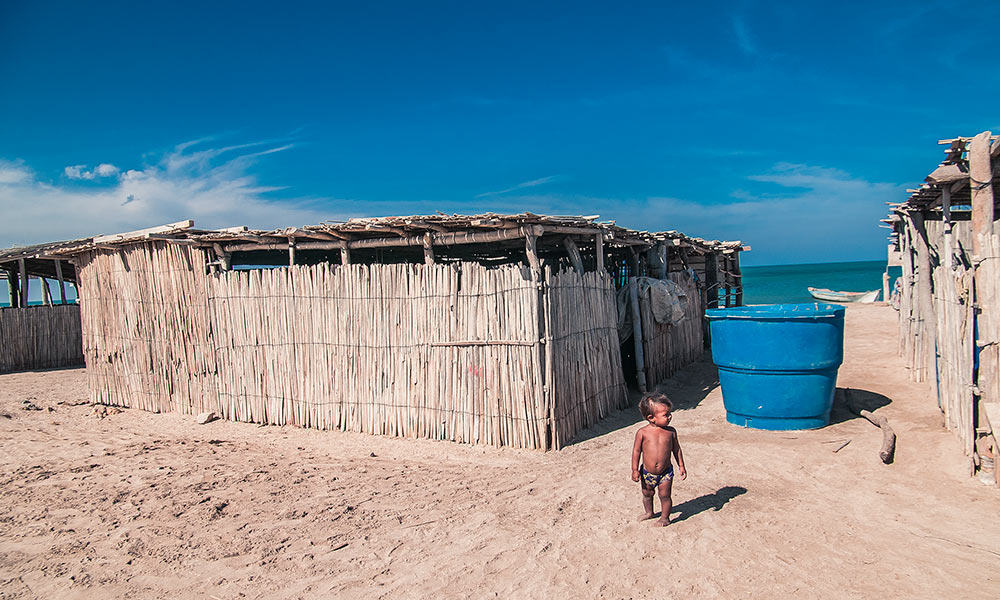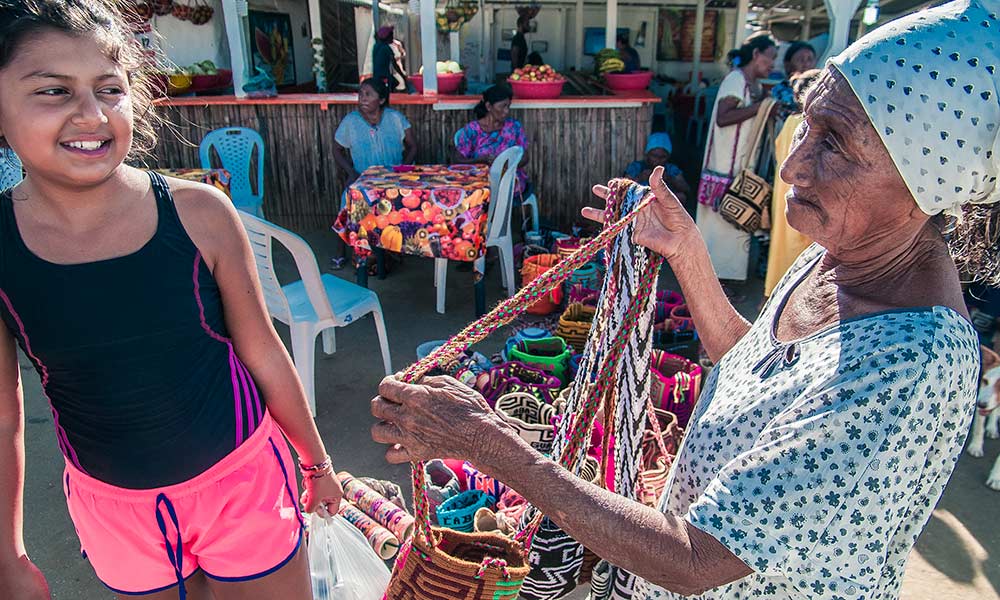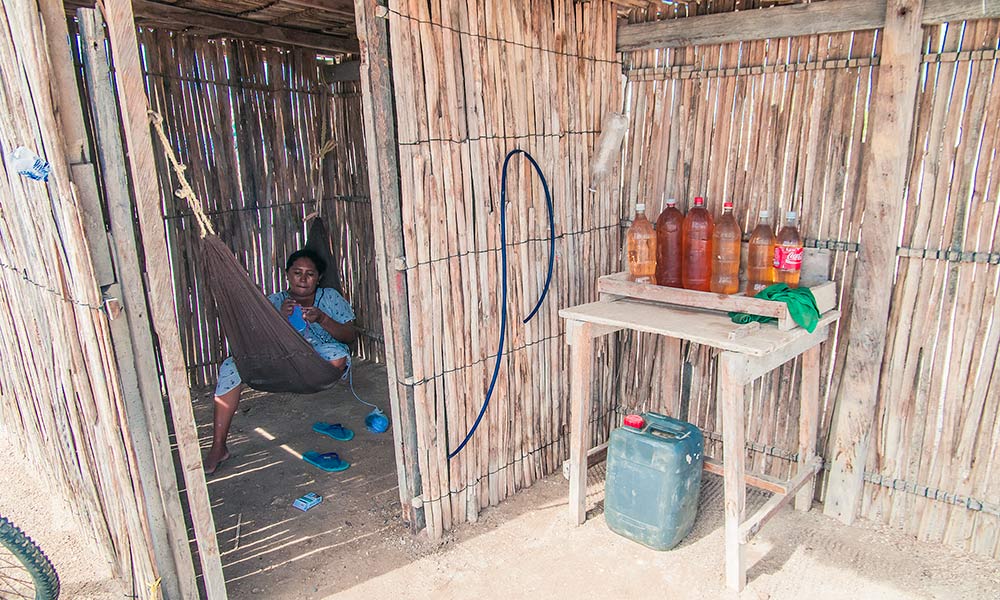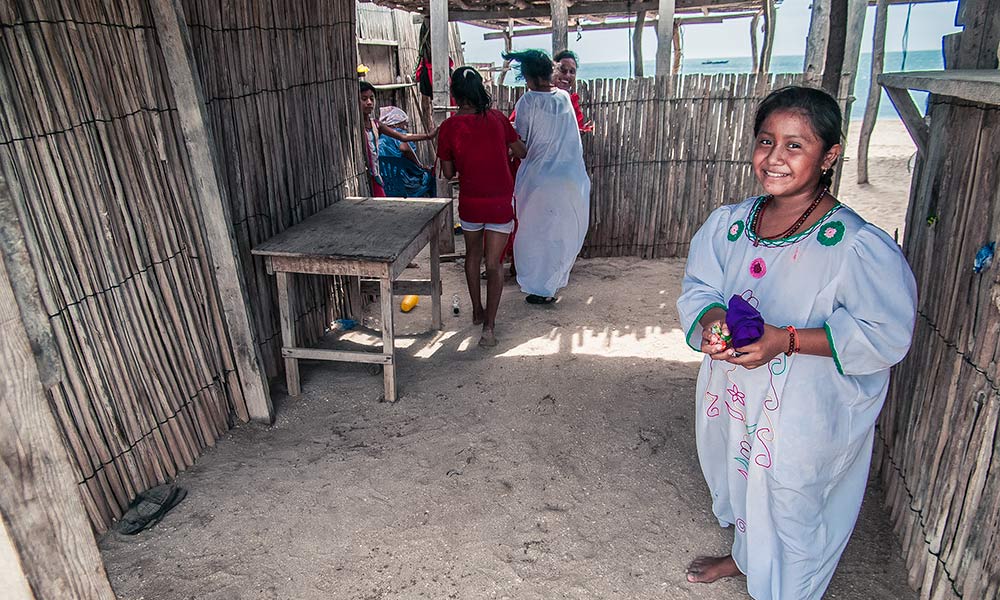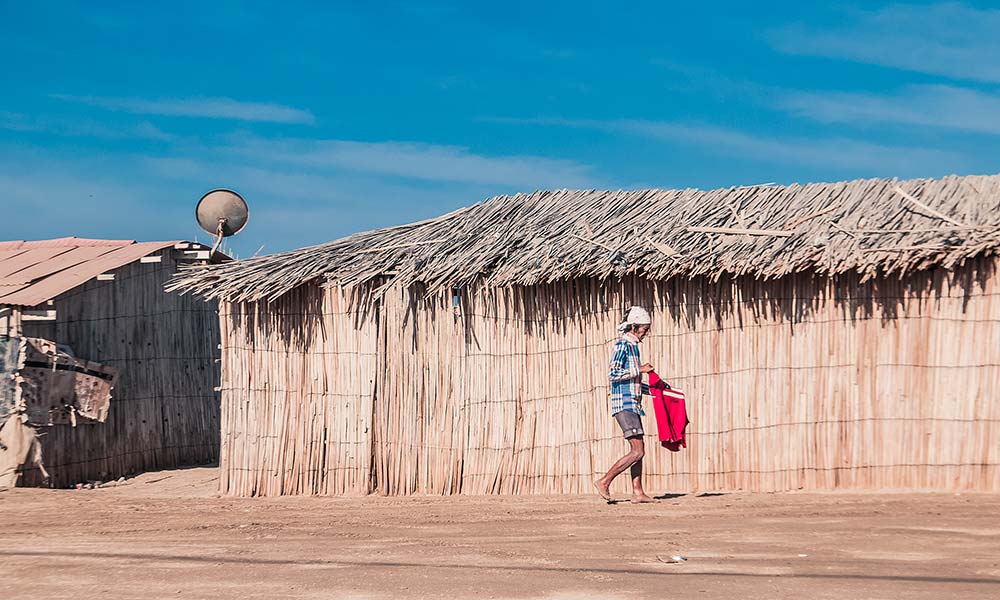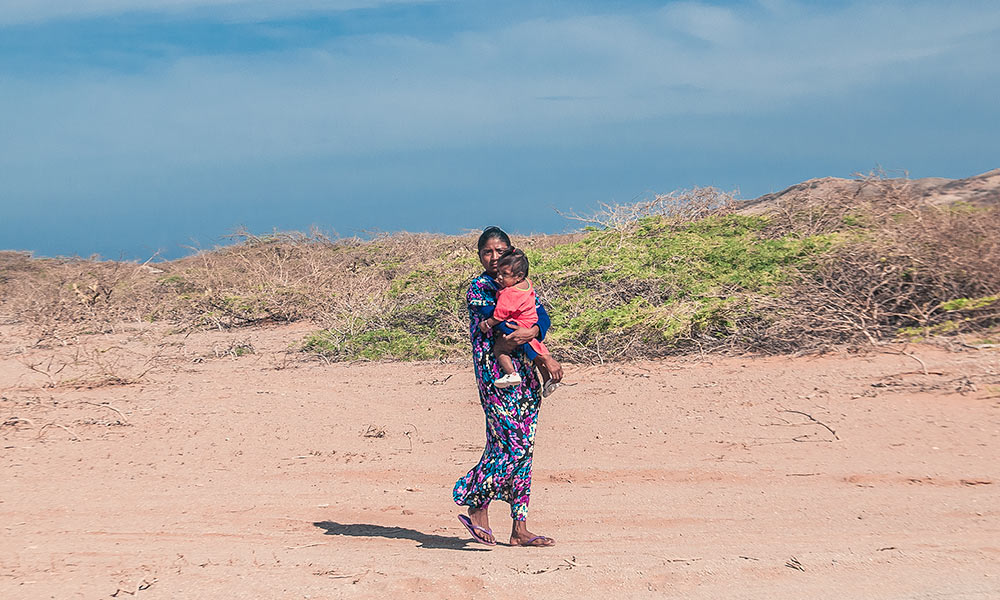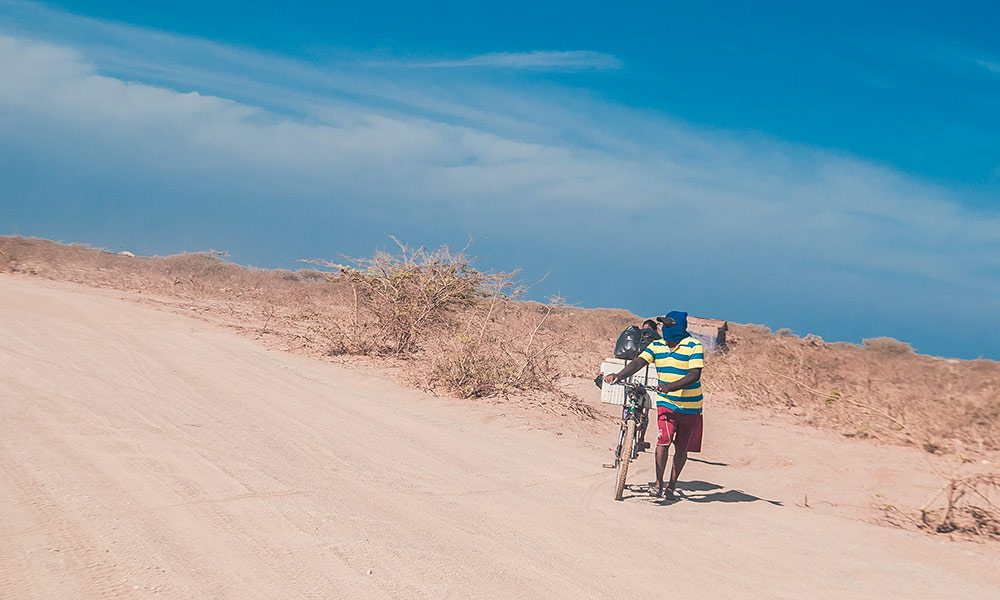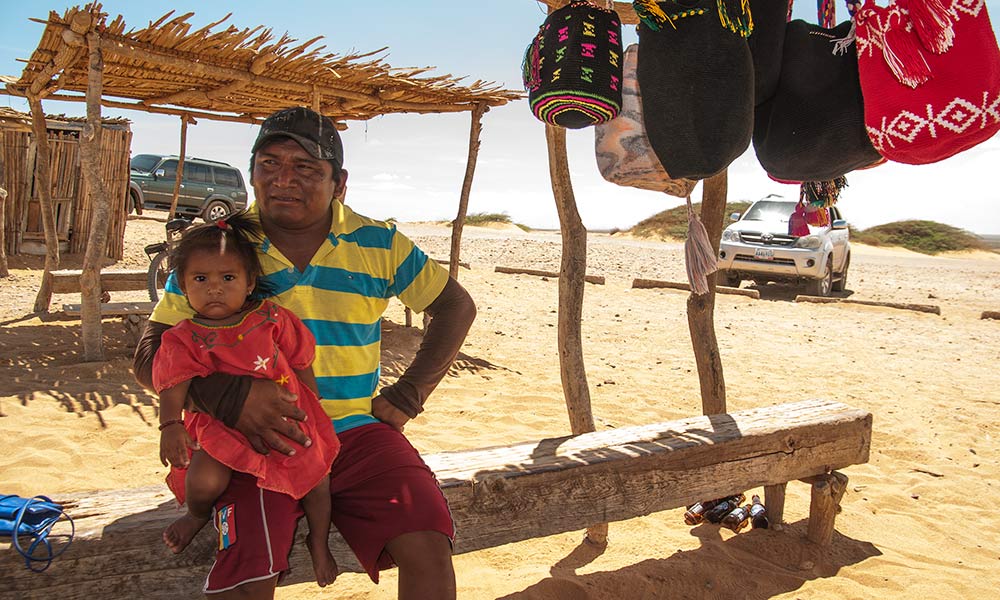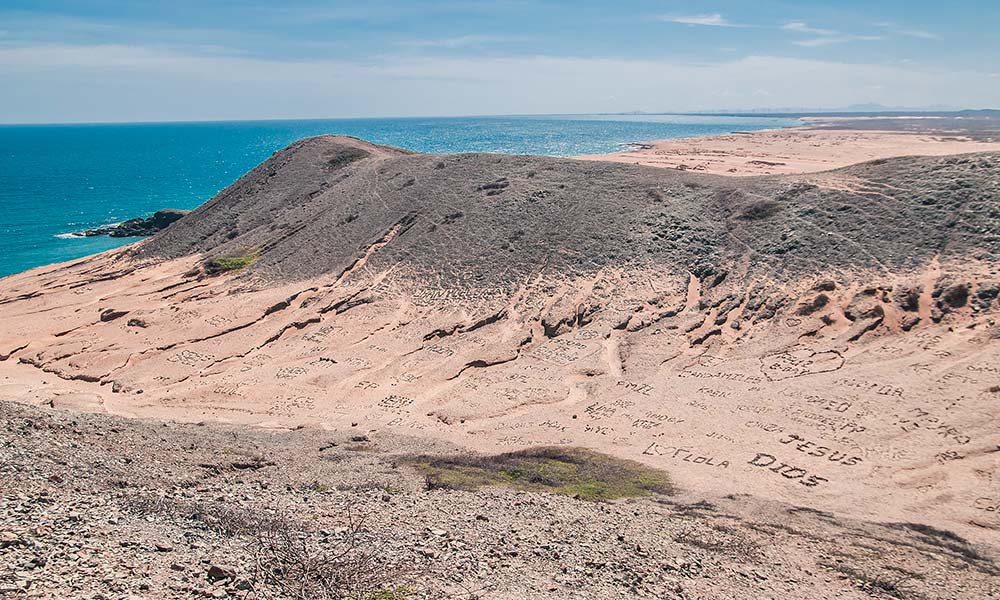Setting foot in Cabo de la Vela does feel like arriving at the end of the world – no more roads, no more running water, even the nature is reduced to its most rudimentary forms. There is an eerie and otherworldly note to it – quite apt in a place where, according to the Wayuu beliefs, the known world meets the unknown. Jepirra, which is how they call it, is the gate to the afterlife that the spirits of the deceased cross on their journey to meet their ancestors.
Getting on the road in Santa Marta or Palomino, still surrounded with the lush greenery of the Caribbean coast, one is ill prepared for the arid landscape awaiting just a few hours away. In Riohacha, the capital of La Guajira department, the traveller bids farewell to the comfort of an air-conditioned bus and has to carry on in a beat-up shared taxi. Soon after leaving the town, the vegetation starts to visibly recede and so do the human settlements. Rancherías, groups of few huts, where typically live the Wayuu, are spread on large areas, due to the scarcity of the resources.
On the coast salmon-coloured packs of flamingos shuffle along the paradise beaches as if to mark the beginning of the Wayuu territory. Kauarainshimana, Yotojohoin, Urarapo – the local topography is written in Wayuunaiki, the language of the Wayuu. Salt mines of Manaure provide another unforgettable visual cue – the salt is mined here with shovels out of the Caribbean Sea right on the beachfront. The Wayuu tribesmen have been working the ponds filled with salt-rich water since the time when the activity belonged more to the realm of alchemy than industry. Today they are trying to reclaim their rights to this part of the land and their share of the profit.
Soon it’s time to get off Troncal del Caribe – a long communicational artery that spans the whole Caribbean coast of Colombia and in only 30 kilometres from here cuts into the Venezuelan border – and head north, towards Uribia. Considered the indigenous capital of Colombia, it is, in a way, the last outpost of civilisation and a quintessential frontier town.
The proximity of the border is obvious and lends the place certain intensity. Venezuelan car plates are about as common as the Colombian ones. Club Colombia is nowhere to be found, wiped out by Polar – a peculiar product of the Bolivarian breweries. State-subsidised gasoline crosses the border in plastic tanks and is sold in “Tierra de nadie”, on the other side. A car comes down the bridge and pulls up in the shadow of a low tree where an impromptu gas station had been set up a moment ago by a Wayuu woman. She sucks on a rubber tube, spits out the gasoline and sticks the end into the fuel filler.
It is the turf of Cielo Redondo aka La Cacica Negra, a two-time mayor of Uribia. After years of orchestrating massive corruption, colluding with the paramilitaries and rigging of local elections, she had to seek refuge in the desert between the two countries where she dodged the authorities for months. Her style of governing is mainstream in the whole La Guajira region. The profits, made from the local natural resources and the number of children and adults dying here of malnutrition, are both stunning figures.
It is also the turf of high-suspension 4x4s. Short drive out of town the barely defined road runs along the railroad that carries away coal from the nearby Cerrejón, a gigantic open-pit mine, one of the biggest in the world. A moment later, the crackly looking shrubs and faint patches of grass finally give in and the sand takes over completely. From this point, Miquelis, the owner of the car and the driver, is the only one who sees the road. The wheels leave a trail of dust in the sizzling air over this sandy plateau that hasn’t seen a drop of rain in two years. The temperature here easily exceeds 30 degrees most days of the year. The combination of heat and high humidity is good for the salt deposits, but hard on humans.
The front of El Rancho de Xiomy, on the southern end of the village, is gleaming with the saturated colours of the Wayuu bags. The humble restaurant is one of quite a few establishments that sprung up along the only road in the last couple of years, as the tourism in the area intensified. On the back, a muddle of hammocks under a thatched roof – for the visitors it’s the cheapest kind of bedding, for the locals, the only type they know. There is also a handful of simple cabañas with beds – for those looking for more upmarket lodgement options. The only thing missing are bathrooms – water is a resource in short supply here and every gallon has to be brought into the desert at a considerable cost.
Outside the rancho four women are sitting around a white plastic table, weaving away. Rows of finished mochilas are pouring out from underneath their feet. They go about their daily chores with a rather gloomy demeanour. They are fairly friendly, but don’t exactly radiate with that jovial and tender, world-loving attitude that we want the indigenous people to have. Even with a longer chat it’s not easy to provoke many smiles on their faces. Life is tough for the inhabitants of La Guajira – after Haiti, the second poorest region of the whole Caribbean.
Looking at the vivid, fluorescent at times hues of the bags and chinchorros made by the Wayuu, one starts to suspect the existence of some internal world of beauty that must be inspiring the weavers, as their surrounding really seems to lack any of this flamboyance. Below the horizon line, where the vibrant blue of the sky ends, the landscape remains in the sepia range most of the time. Except for a few brick buildings, all houses are made of sticks found inside yotojoro – a local cactus which is the only source of wood here. The colour of the walls and roofs made of it is no different to that of the sand below. The same goes for the numerous stray dogs, ground down with the heat, lying around in the patches of shade.
The rocky hills of Cabo de la Vela were one of the very firsts sights that the Europeans caught of the South-American mainland. They might have been looking down over Playa Dorada or the sharp peak of Pilón de Azúcar and in the windswept rocks, whitewashed with the harsh sun, they saw the reflection of themselves – a “Cape of Sails” bouncing on the crests of the waves. As a matter of fact, there’s so much wind and sun in La Guajira, that – with the right technology in place – the energy garnered from them could cover the entire country’s consumption. The reality is though that the lights in Cabo de la Vela go out at 23.00. What’s worse, the fan blades go still as well. Your level of comfort is similar now to what Amerigo Vespucci had at his disposal when he came here with the first expedition, four centuries ago.
Heavenly beaches aside, this is by far the most valuable experience that Cabo de la Vela has to offer – the sensation of being on the very edge of the world, or maybe two worlds even. The time comes to a halt, or perhaps, starts to run in circles again as it once did. The nature, frail and endangered in the Westerners’ eyes stands tall here in all its raw glory – marvellous, but sinister too. On some nights, when the Moon is strong, its light is reflected in the thick, humid air. The glimmering ring with the retina of the Earth’s satellite in the centre looks like a monstrous celestial eye looking down on this land. It doesn’t take a lot of imagination to understand how the Wayuu came to think about this place as a transition zone between this and the higher reality.
